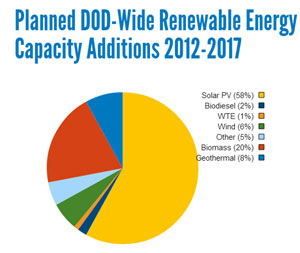Three military bases in Florida will soon be home to the largest solar project in the state.
Eglin Air Force Base (30 MW), Naval Air Station Whiting Field (40 MW), and Naval Air Station Pensacola (50 MW) will send the power to the grid, serving about 18,000 households across northern Florida and the bases. HelioSage Energy will build and own the projects, which come online next year.
With a governor that doesn’t allow the words "climate change" to be spoken at state environmental agencies, it’s not surprising that Florida lags on solar, even with the third strongest resources in the US. It doesn’t have a Renewable Portfolio Standard, doesn’t allow power purchase agreements or third party leasing, and last year, solar rebates were eliminated. Only 22 MW of solar was installed in Florida in 2014.
Solar projects are becoming common at US bases for two reasons. First, the Defense Department (DoD) has made major commitments to transitioning to renewable energy because it considers climate change a major security threat. Last year, DoD announced it is integrating climate change threats into all "plans, operations, and training" across the entire agency.
Second, concerns about terrorists hacking into power plants and natural disasters bringing down the grid make it necessary to develop independent power plants known as micro-grids.
The Air Force is also working with government and business partners to develop a jet engine that uses 25% less fuel.

Nine Army bases are piloting net-zero energy, trying to get there by 2020:
Three bases are going beyond net-zero energy, to include net-zero water and net-zero waste: Fort Bliss in Texas and Fort Carson in Colorado.
If they all reach net-zero energy, it will displace about 8% of the Army’s total energy use.
Here’s an update on how net-zero bases are progressing:
